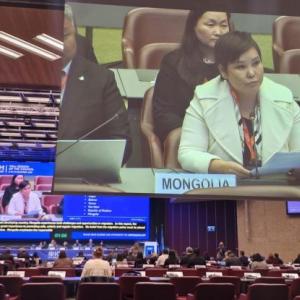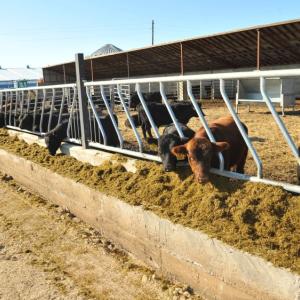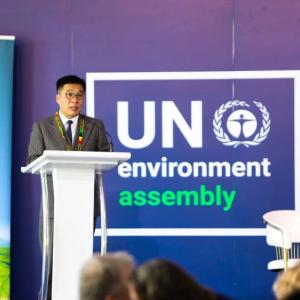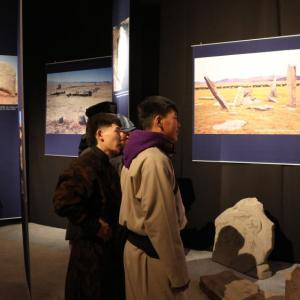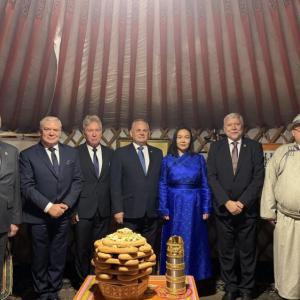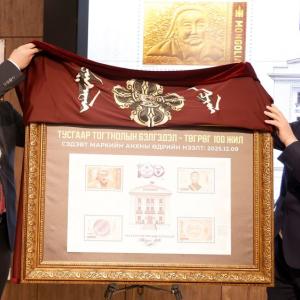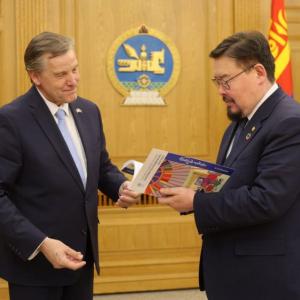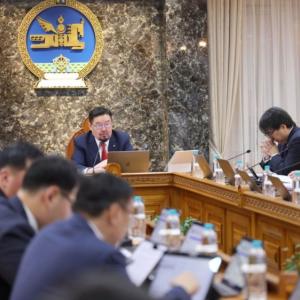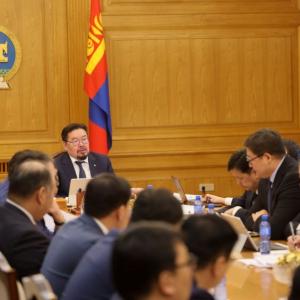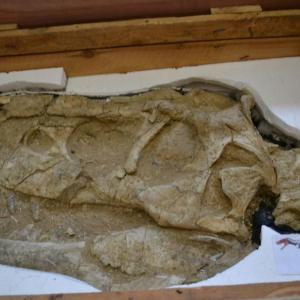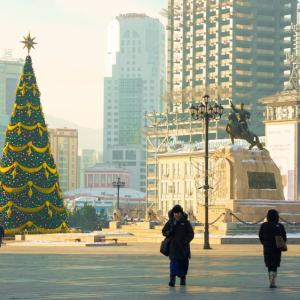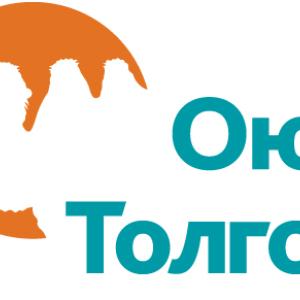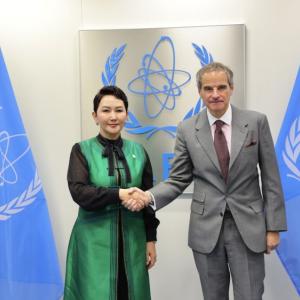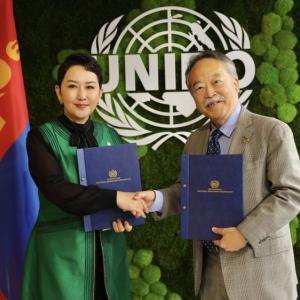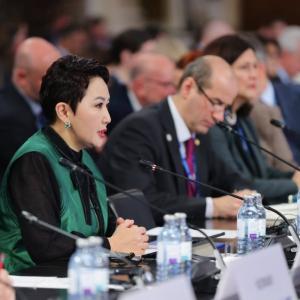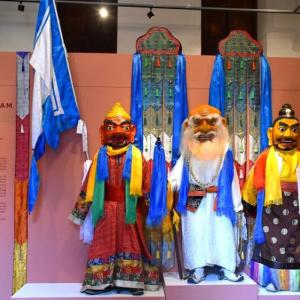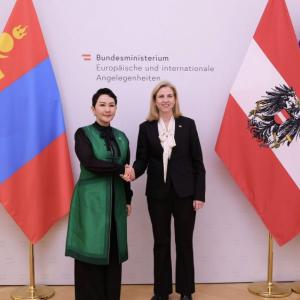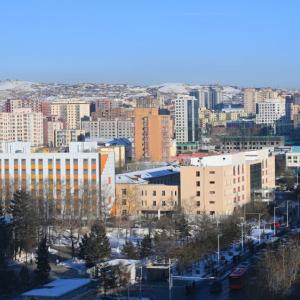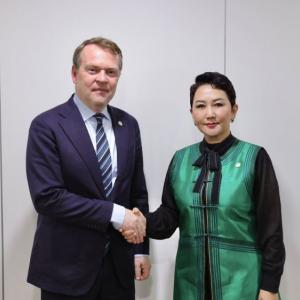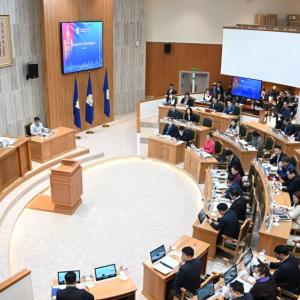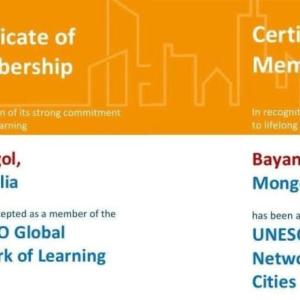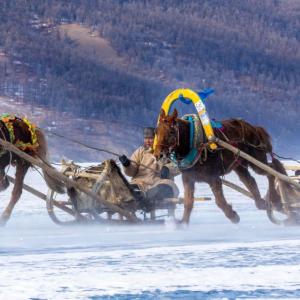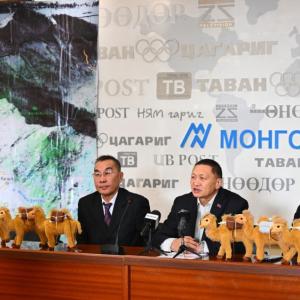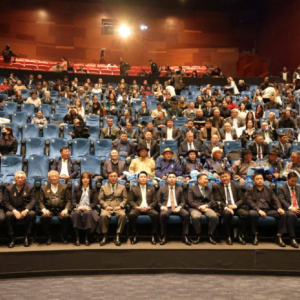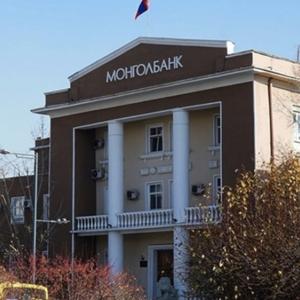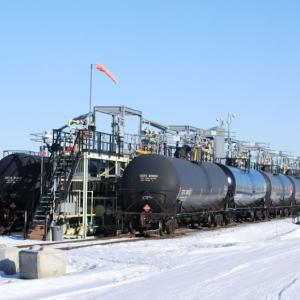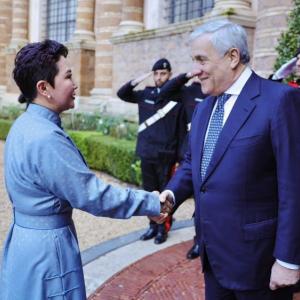Environment
Environment | Environment and TourismClimate change and intensification of negative impacts from human activities caused an increase in environmental pollution, nature degradation, depletion of natural resources, and a rise in the number of threatened and endangered animals and plants species. For example, the air temperature in Mongolia become warmer by +2.1 C degrees in 2010 and about 70 percent of Mongolia’s territory has been affected by desertification processes to some degree. Also, around 5,000 rivers, streams, springs, sources and ponds have dried-up threatening animals and plants with extinction. For this reason, the Mongolian Red Book was updated to protect threatened and endangered animals and plant species
Water
Mongolia is a continental country, with three huge watersheds. Water resources depend mostly on rivers flowing out of the country, but there are comparatively high levels of surface and ground water resources. The rivers belong to the inland catchments basins of the Arctic Sea, the Pacific Ocean and the Central Asia Inland Basin. The upper and middle Selenge, the nation’s biggest river, and parts of the Yenissei river, belong to the Arctic drainage basin. In the north and west mountains, the water network is of high density. The south, central and south-east parts have a few rivers and other water resources, usually in depressions with no outflow.
Mongolia has 3,811 rivers and streams running a total of 67,000km; over 3,000 lakes with a total volume of 500 cubic km; around 6,900 constant springs; over 190 glaciers covering about 540 square km; and over 250 mineral springs from specific water ecosystems. A water census by Nature and Environment Ministry showed how Mongolia’s water reserves have decreased. Over the last five years, 683 rivers, 1,484 ponds and springs and 760 lakes have dried up, due not only to human factors, but also to a loss of natural balance. As a result, the government declared 2004 the Year for Water Policy Innovation.
Many of Mongolia’s rivers have become the sources for bigger rivers and lakes in China and Russia and now flow into the North Atlantic and Pacific Oceans. However water reserves in these Mongolian rivers have been reduced due to climate changes, with some drying up completely. Sands from the deserts in southern Mongolia and northern China are shifting to north-east Asia, even reaching the US east coast and causing a considerable economic damage. Our country’s soil has been greatly damaged with the desert expansion becoming a major factor for increased yellow sand storms
Arctic Basin
This takes up 20.4 percent of Mongolia, including the rivers Selenge and Khuremtei, with tributaries the Ider, Delgermurun, Eg and Shishkhed.
Selenge River
This begins at the confluence of the rivers Delger Murun and Ider and is the main tributary of Lake Baigali, Russia. The Selenge, running for 1,024 kilometres, drains 425,245 square km, of which 282,050 square km (66 per cent) is in Mongolia.
Orkhon River

This is the biggest right bank tributary of the Selenge, draining 132,855 square km. It occupies 47 per cent of the Selenge river basin. At 1,124 km long, it is Mongolia’s longest river, sourced at the northwest of Khangai mountain. Mongolia’s biggest waterfall, Ulaan Tsutgalan, is situated there. The Tuul and Kharaa rivers drain into the Orkhon. The Pacific Ocean basin major rivers are the Onon, Ulz, Khalkh and Kherlen, tributaries of the Amar river. The total length of rivers with permanent flow is about 2,000km; add rivers with irregular growth and the total length is about 8,000km.
Pacific Ocean Basin
The Onon river runs from the hot mineral springs of the Khentii mountains, draining 94,010 square km. Its total length is 808km, of which 298km are in Mongolia, originating from the river Shilca, a tributary of the Onon and Amar rivers. The Onon flows through mountainous forested areas.
Kherlen River
The Kherlen is sourced from the south of a mountain in the Khentii range, 1,750 metres above sea level. It flows east then south and joins Lake Dalai in China. The Kherlen is 1,264km, 1,090km of which is in Mongolia, at first through densely forested mountains, then east to the wooded steppe.
Ulz River
This has its source in mountains on the east of the Khentii range, and flows between the Onon and Kherlen rivers. It drains into Russia’s Lake Tooroi.
Khalkh River
This river flows from the Ikh Khyangan mountains and branches into two near Lake Buir. The left branch drains into Lake Buir and the right into the Orshuun river. The Khalkh is 233km long and drains 30,465 square km, of which 12,775 square km are in Mongolia.
Bulgan River
The Bulgan, Uench and Bodonch rivers, which start in the southern face of the Mongol Altai mountains, are part of the blind Central Asian drainage basin. This includes the Buyant, Khovd, Tsenkher, Sagsai, Sogoog and tributary rivers, which rise in the north of the Mongol Altai mountains.
Khovd River
The Khovd is sourced in the north of the Mongol Altai mountains and runs into Lakes Khoton and Khorgon. Running for 593km, its largest tributaries are the Tsagaan Khovd and Khar Khovd.
Zavkhan River
This runs from the southern face of Otgontenger mountain, the highest peak of the Khangai range. It first flows from the confluence of the Buyant and Shar Us rivers. The Zavkhan flows on the west of the Khangai mountain into Lake Airag, which is connected to Lake Khyargas. It runs 808 kilometres and provides most of the tributary flow into Lake Khyargas.
Biggest Lakes
Lakes are a significant geographical feature in Mongolia. The mineral and chemical mixture of the lakes depends mainly on geological formation of surface and underground water and physical and geographical conditions of drainage areas. The mineral and the chemical compounds are determined by the lake salt balance, water exchange and outside flow.
Lake Khuvsgul
The best known and most notable mountain lake in the country is Khuvsgul, the deepest lake not only of Mongolia, but of Central Asia. Khuvsgul is 136km long, 36.5km wide, and in the middle is 262 metres deep. Its area is 2,760 square Its area is 2,760 square kilometres. A fresh water lake, it has low mineralization (140-240 milligrammes per litre), ion variation and hardness (1.1-2.9 milligrammes per equivalent litre). It has weak and variable alkalinity (7.4-8.2). Over 90 rivers and stream flow into the Khuvsgul, and the Eg river flows out.
Lake Khar–Us
This lake lies at 1,157 metres above sea level, with an area of 1,852 square kilometres, 72 kilometres long, 27km wide and only four metres deep. This fresh water lake has few minerals (180-330 milligrammes/ litre in winter, 110-260 milligrammes/ litre in summer).
Lake Terkhiin Tsagaan
The lake is 206 metres above sea level, covering 61 square km. It is 16km long, with a shoreline of six km and an average depth of six metres. This fresh soft water lake has low mineralization, varying between 160-210 milligrammes/ litre in winter and 100-180 milligrammes/ litre in summer.
Lake Buir
The area of its water plane is 615 square km, its length is 40km, its width is 21km and its maximum depth is 10.5 metres. This is a soft and fresh water lake.
Lake Khyargas
The area of its water plane is 1,407 square km. The salt and alkaline water is highly mineralized (1,000 milligrammes/litre), and these minerals and salt ions are unstable. The Khyargas has no outflow. The direct influences of lakes of the Central Asian blind drainage basin on the ecosystem are relatively few. Ecological conditions decline when there is less water because of tributary flow variations and cyclic climate variations. The low water period has been extended in rivers of the Lakes Valley over the last 20 years.As a result, the water level of Lake Buuntsagaan has dropped and Lakes Taastsiin Tsagaan, Orog and Ulaan have dried up.
Biodiversity
There are several laws and regulations to protect biodiversity. In 1996, the government adopted a Biodiversity Conservation Action Plan, and signed CITES (the Convention on International Trade in Endangered Species of Wild Fauna and Flora).

Fauna
Mongolian has animals of the in forest, steppe, desert, alpine, tundra and talus, including many animals commonly found in the Siberian taiga, European-type forests, and western Asian and Turan desert. There are many which are endemic only to deserts and steppes of central and east Asia. Mongolia was also home to now-extinct prehistoric and more recent creatures. A total of 138 mammal species, 449 bird species, 75 fish species, six amphibian species and 22 reptile species are registered in Mongolia. There are also over 13,000 invertebrate species, including 516 insects, worms, fresh water and terrestrial molluscs. Of the mammal species, 24 are still widely hunted, 32 are lightly hunted and four not hunted. A total of 30 mammal species and sub-species have been included in the rare and very rare classifications of the Mongolian Red Book, revised in 1997. Habitats of the Gobi bear (ursus pruinosis), wild camel (camalus bactrianus), takhi (Przewalskii horse), elk, scrofa nigripes and Asian beaver are now totally protected. Over 70 percent of the habitat of the snow-leopard, equus hemionus, river otter, haze musk deer, ovis amman and capra sibrica are also in the special protection network. Re-introduction and re-acclimatizing of valued hunt prey like muskrat, stoat, raccoon, procapra fulturosa, moschus moschiferus, takhi, Asian beaver and capra sibrica are being carried out.
Takhi

The takhi are the last remaining wild horses in the world. Also known as the Przewalski horse (named after the Polish explorer who first identified the horse in 1878), the takhi is perhaps the most recognized symbol of preservation and protection of Mongolia’s diverse and unique wildlife. The last wild takhi was seen in the western Gobi in 1966. However, there were specimens reared in zoos all over the world. The Mongolian Association for Conservation of Nature and Environment and the Dutch Foundation Reserve of Przewalski Horses reintroduced the takhi to the wild in 1992. Takhi populations in Khustai Nuruu (Tov Aimag) and Bugat soum (Govi-Altai Aimag) have now reached around 200. In 2004, 20 takhi were re-introduced into the Khomiin Tal buffer zone of the Khar-Us Nuur National Park, financed by the French Takhi Association and WWF Mongolia. Research between 1998 and 2000 led to the belief that reintroduction of takhi to Khomiin Tal was possible because of its low population density, and that it could carry up to 500 horses.
Gobi Bear (ursus pruinosis)

A comparative survey on the common bear and the Gobi bear showed that Gobi bear fecundity was up to 90 per cent, and its rearing up to 24 per cent, below other bears. The male Gobi bear begins to breed from five years and the female starts from four years. This indicates the need for measures to protect the Gobi bear genetic resource. Observation was undertaken of the Gobi bear habitat in Khukh Ders, Khatuu Bulag, Altan Tevsh, Suuj Bulag, Mukhar Zadgai, Tsagaan Burgas, Khushoot and Sharkhuls oasis. Fresh footprints were identified at the Khajuu Bulag spring, Segs Tsagaan Bogd mountain, and photos and video were taken of a full-grown Gobi bear eating. Fresh footprint of one, possibly two Gobi bears were identified at the Tsagaan Tokhoi fodder point and near the Khajuu Bulag spring and measured.
Birds
Mongolia has registered 434 bird species belonging to 193 genera, 56 families and 17 orders. Over 330 of these species are migratory, while the rest live here year round. About 50 species migrate through Mongolia and another 20 species are observed occasionally. The Mongolian Red Book registers 30 bird species which are rare worldwide. As a result, parts of big lakes and rivers densely inhabited by birds have been protected, including Lakes Khuvusgul, Uvs, Khar-Us,Dayan, Khorgo and Terkhiin-Tsagaan. The Daguur, Dornod and Numrug Strictly Protected Areas were established to protect the Siberian Crane (grus leucogeranus), white-naped crane (grus vipio), houbara bustard (chlamydotis undulata), black stork (ciconia nigra), Dalamatian pelican (pelicanus crispus), white spoonbill (platelea leucorodia), Baikal teal (anas formosa), Asiatic dowitcher (limnodromus semiplamatus) and relict gull (larus relictus).
Fish
Mongolia is landlocked, so it has no sea fish. Mongolian rivers and lakes relate to three basins: the Arctic, the Pacific and the Central Asian. Fish of each are different. There are 75 fish species belonging to 36 genera and 11 families in the Mongolian water basin. It has been estimated that up to 700 tonnes of fish are taken every year from lakes and rivers. An Environment Ministry report said that, since 2000, the amount caught has been consistently declining, with 322 tonnes in 2001, falling to 250 tonnes in 2002. The 1995 Hunting Law, with other laws and regulations, is helping preserve the fish population. The Amur sturgeon (acipenser shrenki) and Siberian or Baikal sturgeon (acipenser baeri) are protected and the glass (Chinese) carp (ctenogharyngodon idella), silver carp (hypophthalmicthys molitrix) and tench (tinca tinca) are registered as endangered. Another six fish species have been included in the Red Book and conservation measures taken. To preserve fish stocks and to maintain favorable breeding conditions, several lakes (including Khuvsgul, Uvs, Terkhiin Tsagaan, Dayan, Khoton and Khar Us) and some parts of rivers are protected areas.
Amphibians and reptiles
In an eastern Mongolian ecology variety project, surveys were carried out in the basins of the Kherlen, Khalkh and Numrog rivers. They revealed that eastern Mongolia had four of the country’s twelve amphibian species and two of the eight reptile species. Two basic steps have been taken to protect Mongolia’s amphibians and reptiles.
- Two species of the eastern Mongolian gerpetofoun (hynobius and the eastern frog) have been included in the Red Book.
- Amphibians and reptiles are included in the special protected areas.
- Amphibian and reptile populations are affected by factors such as climate, birds of prey, parasitic disease and human activity.
Flora
Mongolian vegetation presents special features which have developed through time and because of local landscape forms, the environment and climate. Mongolia is a site of convergence with flora originating both in the Great Siberian Taiga and the central Asian steppe and desert.
Mongolia has acquired plant species from Manchuria in the east and from the Kazakhstan–Turan area in the west. The gradual transition from high mountain taiga, to mountain forest steppe and flat grassy plains, and on to semi-desert and true desert, offers features of the world’s three basic vegetation regions. This is reflected in the change in precipitation and plant distribution, from foothills to the tops of mountain ranges in vertical belts. Mongolia has over 2,823 plant species, while central Siberia has 2,400 and Inner Mongolia has 2,176.
There are 845 species of medicinal plants; over 1,000 of fodder plants; 173 of food plants; 489 of ornamental plants; and 195 of other significant plants. Mongolia has 2,095 species of herbaceous plant and 348 species of woody and shrubby plants. These comprise 17 species of big trees; 40 species of low trees and gig shrub; 146 species of shrub; 48 species of sub-shrubs; 91 species of partial sub-shrubs; 6 species of fodder and herbaceous; 1,765 species of longevity plants; 330 species of one- and two-year vascular plants; 21 families of flat moss; 38 families of leafy moss; 53 families of lichen; 1,236 species and sub-species of algae; and 900 species of mushrooms. There are relic species from prehistoric desert, forests, tertiary lakes, savannahs and the Ice Age in particular, many native to Mongolia. There are about 150 endemic vascular and lower plants, such as stipa mongolorum; adonis mongolica; betula mongolica; atraphaxis bracteata; calligonum gobicum; nanophyton mongolicum; gymnocarpus przewalskii; silene mongolica; potaninia mongolica; chesneya mongolica; astragalus gobicus; oxytropis ulzii-chutagii; and armisia gobica.
The Khangai, Gobi-Altai and Mongolian Altai regions are the most abundant in species. Eighty-six plant species were registered as endangered or threatened in the first edition of the Mongolian Red Book. In the second edition (1997), this had increased dramatically, and included 75 medicinal species, 11 of food, 16 used in industry, 55 decorative species and 15 species used in soil fixing or controlling pests. The group includes nitraria sibirica; amygdalus mongolica; populus diversifolia; caragana bungei; artemisia caespitosa; sophora alopecuroides; allium altaicum; adonis mongolica; saussurea involucrate; agriophyllum pungens; elaeagnes moorcroftii; aves sibirica; gemnocvarpus przewalskii; rodiola rosea; and allium oliquum. A law was passed in 2003 on international trade in animals, plants and related items, resulting from Mongolian membership of the 1975 CITES (Convention on International Trade in Endangered Species of Wild Flora and Fauna. Failure to meet convention standards results in an embargo on exports and imports, and stopping of financial assistance and support from other signatories.
Mongolia joined CITES in 1996 but still earns Tg1.5 billion from the international trade in endangered native flora and fauna. Mongolia has 14 mammal species, 71 birds, eight plants and two fish on the CITES protected list. These include the takhi, mazaalai (Gobi bear), snow leopard, wild ass, Siberian crane, white–naped crane, Dalmatian pelican, Macqueen’s (Houbara) bustard, relict gull, Japanese crane and the oriental white Mongolian stork. However the grey wolf, lynx, musk deer, argali, saker falcon, apollo butterfly, European wild cat, Eurasian otter, elk, moose, tatar sand boa, Siberian and Amur sturgeon can still be traded with CITES permission. The Environment Ministry has a council to license such trade.
Forests
Since 1990, the forestry sector institutional and legal framework has changed several times. Legislation includes the Forest Law; Protection against Forest and Steppe Fire Law; National Forestry Policy Law; and the National Forestry Master Programme. A National Forestry Council was formed in 2001 to revitalize the timber industry. Forests cover 18,921,800 hectares (8.1 per cent) along the watershed of the three big basins. They help retain river water resources, stop soil erosion, soften the climate, absorb greenhouse gases, are home to animals, plants and micro-organisms, and hold down permafrost. There are about 140 varieties of trees and shrubs, forests being 84 per cent coniferous or broad-leaved trees, the other 16 per cent being haloxylon ammodendron.
Coniferous and broad-leaved trees cover 10,465,300 hectares, haloxylon ammodendron cover 2,040,900 hectares. Larch accounts for 58.8 per cent, cembra pine 5.2 per cent, birch 8.8 per cent, pine 7.7 per cent and haloxylon 16 per cent of all woodland. There are small areas of spruce, fir, poplar, aspen and willow. Mongolian forests grow in central Asian conditions of extreme climate, and are very susceptible to fire, insect damage and adverse human activity.
As studied by researchers, globally, around 10 percent of greenhouse gas emissions are generated through forest loss and forest degradation. Forests cover only about 8 percent of Mongolia’s total land area; therefore it is still an impressive 110,000 square kilometers, the size of the total land area of Bulgaria. As such, Mongolia can play a significant role in climate change mitigation through the sustainable management of its forests and restoration of degraded forests. This is also important because Mongolia ranks in the top 8 of the most vulnerable countries to climate change with average temperature increases over the last 70 years having already surpassed the 2 Degrees Celsius mark. The effects such as desertification, higher likelihood of dzuds, melting glaciers, etc, impact heavily on Mongolia’s natural-resource dependent nomadic herders.
Nature protection
Mongolian culture is strongly influenced by shamanistic traditions and Tibetan Buddhism, both of which emphasize a powerful connection with nature. Chinggis Khan and other subsequent Mongolian leaders regulated hunting of some species through closed seasons, prevented logging and hunting on sacred mountains and in 1778 declared the country’s — and world’s — first national park.
Despite Mongolia’s strong tradition of protecting natural resources, its biodiversity is imperiled by rapid change and development. Expanding mines, oilfields, roads, railroads and agriculture, combined with deforestation and climate change, threaten the long-term prospects of this landscape. Overgrazing, over-hunting and poaching are also negatively affecting protected areas and vital interconnecting habitats that are necessary for effective grassland conservation. The Mongolia steppe presents one of the last and best opportunities on Earth to protect grasslands and savanna at a scale big enough to support the wildlife and nomadic people who have relied on these lands for millennia, and who will continue to depend on them in the future. Preserving the natural systems of these vast landscapes and recognizing the needs of the local people is imperative for lasting conservation in Mongolia.
In 2012, Mongolia’s Parliament adopted the revised ‘Law of the Protection of the Environment’, ‘Law on Fauna’, ‘Law on Natural Plants’, ‘Law on Forests’ and ‘Law on Natural Resource Use Fees’. With the ratification of these new laws, 31 endangered species of animals and 133 species of endangered natural plants were strictly protected and the use of 35 critically endangered species of animals and 353 species of natural plants were restricted.
Mongolia is signatory to many international conventions and agreements such as the ‘Convention on Biological Diversity’ (1993), ‘Convention on International Trade in Endangered Sepcies of Wild Fauna and Flora’ (1996) and ‘Convention on Wetlands of International Importance, especially, as Waterfowl Habitat’ (1999). In addition, in line with the Strategic Plan for Biodiversity 2011- 2020, Mongolia’s Parliament ratified the Aichi Biodiversity targets, the national biodiversity action plan for conservation of very rare, rare animals and the National Biodiversity action plan for conservation of natural plants.
The updated ‘Third Edition of the Mongolian Red Book’ was developed under the guidelines and principles of the ‘International Red Data Book’ and ‘Red List of Threatened Species assessment criteria for animals and plants’ released by the International Union For Conservation of Nature, the animals and plants evaluation criteria from the Mongolian Law on Fauna, and the Law on Natural Plants and the article 19.2 ‘Registration and protection of very rare and rare animals and plants by entry in the Red Book of Mongolia and international red books and other relevant agreements, convention annexes’.
Special Protected Areas

Mongolia has been working on a policy to protect all mountains and ecosystems and properly exploit minerals. The country is concerned to place areas that differ from others in biosphere under special protection and preserve biological varieties. These include the Mongol Daguur, Dornod Mongol and Khalkh Numrug reserves, which retain relatively intact ecosystems. At present, special protection covers a total of 20.6 million hectares in 127 places around Ulaanbaatar, in 19 aimags and 50 soum areas. They make up 13.2 per cent of all land, 17.3 per cent of the forest reserve, 55 per cent of the hydrosphere and about 40 per cent of the distribution of rare animals and plants. There are projects involving two million hectares of the special protected areas, regarded as being especially important for the stability of the Mongolian ecology, while helping develop sustainable livelihoods for residents. In 2002, 140,000 hectares, including an area near the Tujiin Nars Pine forest on the boundary of Selenge aimag’s Altanbulag and Shaamar soums, and some parts of the Myangan-Ugalzat Mountain range in Tsetseg soum (Khovd aimag) were taken under special protection. The Nature and Environment Ministry has added 280,000 hectares to special protection, twice as much as in 2002.
The World Biosphere network involves the ecosystem of the Bogd Khan mountain; the basin of Lake Uvs; the Gobi Gurvan Saikhan, a part of the Great Gobi Reserve; and the Khustai mountain range. The Mongol Daguur protected area, Lake Terkhiin Tsagaan, the Ug, Taats, Buuntsagaan, Adgiin Tsagaan and Airag lakes, Lake Orog in the Lakes Depression, and the Lake Khar-Us national park have been registered in the World Ramsar Convention.
The Mongol Daguur reserve is part of the northeast Asian international network to protect the crane. Lakes Terkh and Ugii are involved in the international network to preserve geese and ducks.
Tourism
Mongolians are very friendly, outgoing people. They are innately helpful and enjoy having guests and visitors in their country and their homes. Visitors are made welcome wherever they go, whether in the capital city, one of the outlying towns and soums, or while visiting historical sites and archeological digs to be found throughout the land. No matter where a visitor travels in Mongolia, he is always surrounded by the warm hospitality of Mongolian people.
A distinctive and original culture, old-time hospitality, a remarkable variety of scenery and rich animal and plant kingdoms exert a fascination for tourists to Mongolia. Since the country adopted a market economy in 1990, tourism has become a vital contributor to national development and a major factor in Mongolia’s involvement in globalization. Before 1990, tourists came mainly from the USSR and the communist bloc. Juulchin was the state-owned monopoly tourist agency. After 1990, there has been a massive increase in the number of tourist from the western countries.
For now, Mongolia ranks 99th among world 140 countries on the tourism competitiveness index and 19th among 25 countries in the Asia- Pacific region. Mongolia’s goal is to increase the amount of tourists by up to one million in next few years, promote tourism as a national priority of the government, develop it with state and private partnerships, bring its competitiveness index to 80th in the World, and ensure that tourism will account for about 14 percent of GDP. These objectives were put forward in the National Development Complex Policy of Mongolia. In the framework of these goals, a ‘Green Development Policy’, ‘National Program of Tourism Development’, ‘Plan on Sustainable Tourism’ and ‘Plan on Special Interest Tourism’ were worked-out.
The number of tourists visiting Mongolia is increasing year by year. Last year, we have received 390 thousand tourists and this year, we are expecting 400 thousand tourists.
Tourist attractions in Mongolia focus on scenery, historic features and cultural heritage.Mongolia has diverse and distinctive flora and fauna, including rare animals like the argali wild sheep, the takhi (the only wild horse species, also called the Przewalski horse), the Asiatic wild ass, wild bactrian camels, snow leopard and ibex.
Many many dinosaurs have been found in the Gobi desert, with stunning examples displayed in Ulaanbaatar’s Natural History Museum.
Mongolian history centres on the world-famous Chinggis Khaan (whom foreigners call Genghis Khan), the13th century warrior-statesman who united the varied tribes into the Mongolian nation that controlled the greatest land empire the world has ever seen.
The two major national celebrations are Naadam, an annual summer festival of the three traditional so-called ‘manly games’ of horse racing, wrestling and archery; and Tsagaan Sar, the lunar New Year, marking the theoretical end of winter and coming of spring.
These festivals are the most anticipated events for both Mongolians and tourists and should not be missed.
Ulaanbaatar
Ulaanbaatar, the capital city, is on the Tuul river, surrounded by majestic mountains.
The combination of these pine-clad mountains, wide boulevards, vast public squares and many parks give the city a spacious feeling, while the ger districts and bustling marketplaces give it a rustic charm.
90 percent of all the tourists coming to Mongolia come through the international airport in Ulaanbaatar, so ‘Friendly Ulaanbaatar’ program being implemented by the Capital city’s administration is giving a positive approach to the tourists. The most visited city sites are Sukhbaatar Square, Gandan monastery and the Zaisan Hill Memorial.
The main museums are of National History, Natural History, Fine Arts, Choijin Lama temple, and the Bogd Khaan palace. Other cultural sites are the National Art Gallery, the Opera and Ballet and the Drama theatres, and cashmere factories.
“The Mongol Naadam” complex under construction is one of the major projects the city is implementing with the aim to promote cultural tourism. The Zaisan Hill complex is renovated. The project paper to develop Gandan Monastery area into a cultural tourism district has been completed. All historical sites of the city now bear addresses both written in Mongolian and English with background info. All these are first steps in promoting cultural tourism. Saridag Monastery ruins and thye Aglag Meditation Temple near the Capital were developed into new tourism destination sites. The Governor of the Capital City and Mayor of Ulaanbaatar has proposed to re-establish the tradition of organizing Danshig Naadam events, previously organized by monastic entities up until early 20th century.
Kharakhorum
Kharakhorum is one of the country’s major tourist destinations.
The site of Chinggis Khaan’s fabled city, administrative centre of an enormous empire, Kharakhorumwas founded in 1220 in the Orkhon valley, at the crossroads of the Silk Road.
It was the seat of power of the Mongol Empire until Khubilai Khaan moved to Beijing.
The city was destroyed and its materials used to build the monumental 400m walls and 108 stupas that surrounded Mongolia’s first Buddhist monastery of Erdene Zuu, built in 1586.
Inside the walls by 1792 were 62 temples and 10,000 lamas, and stone turtles marked the boundaries, two of which can still be found.
Nearby are Tureg monuments and rock inscriptions dating from the 8th and 9th centuries.
Gobi
The Gobi desert, in the south, is a vast zone of desert and desert steppe covering almost 30 percent of the country. The area is often believed to be a lifeless desert, but is actually mostly steppe, inhabited by camel herders, rich in wildlife. Mongolians count 33 different sorst of gobi, and sandy desert makes up only three per cent. The temperature climbs to plus 40C in summer and as much below freezing in winters. It is home to the bactrian (two-humped) camel, and Gobi people hold a camel festival and camel polo every year. Here, in 1923, a US Natural Histroy museum expedition led by Roy Chapman Andrews found the first nest of dinosaur eggs the world had ever seen.
Lake Khuvsgul
Known as the Dark Blue Pearl, Lake Khuvsgul is Mongolia’s largest and deepest lake. In the northernmost aimag, its outlet is the largest tributary to Siberia’s Lake Baigali (Baikal). At 1,645m above sea level, it is frozen from January until April or May, after which a ferry runs between Khatgal and Khankh, the northern and southern towns within the boundaries of the National Park. Here, shamanism survives as a religion among the Darkhads, and the Tsaatan rear reindeer. Tourists can trace the lake shores by horse, foot or on ship Sukhbaatar.
Fishing is allowed with a $3 licence for the abundant taimen, Siberian whitefish and grayling, lenok, umber, Baigali omul and river perch. Lake Khuvsgul is an important migration route for birds from Siberia, haven for birdwatchers. The Dayan Deerhiin cave has ancient wall paintings.
Khuvsgul Lake National Park has become one of the most popular tourism destinations in Mongolia. From 2011 to 2014, the number of annual tourist visits to the Lake increased from 11 thousand to 60 thousand thanks to improved road access and reduced visa restrictions.
Amarbayasgalant Monastery
This is 360km north of Ulaanbaatar, and can be reached by jeep or by a local train. Built 1727-1736, it was the second most important monastery after Erdene Zuu.
Terelj
Open all year, Terelj (meaning dahurian rhododendron) is a spectacular valley park only two-hours drive from Ulaanbaatar, with green meadows carpeted with a dazzling variety of edelweiss and other wildflowers, fascinating rock formations against a backdrop of pine-clad mountains and wooded streams.
It has been called ‘a museum of nature and the animal kingdom.’
Khan Khentii
The homeland of Chinggis Khaan, Khan Khentii is covered with forests, taiga and mountain forest steppe. It is described in The Secret History of Mongols, and is a protected area north-east of Ulaanbaatar.
Manzushir Monastery
This is in a luxuriant valley of the Bogd Khan mountain, Tuv Aimag, an hour’s drive from Ulaanbaatar. The monastery was established in 1733 with 20 temples and 300 monks.
Destroyed in 1932, the only remaining temple has been restored and a museum tells its story.
Khorgo
Khorgo is an extinct basalt-covered volcano east of Lake Terkhiin Tsagaan National Park, Arkhangai Aimag, with interesting bubbles of solidified lava called the basalt gers.
Tourist camps
There are over 100 tourist camps with 5,300 beds in 16 aimags, mant featuring ger accommodation, with an average 25 gers, each with four beds. Of them, 26 have a one-star rating, 21 are two-star. There are 197 hotels with 5,000 beds in Ulaanbaatar, employing over 2,000 staff. In the aimags there are 81 small and medium hotels, with 3,000 beds. Of these, five are rated one-star, 17 two-star, eight three-star and one is four-star. Most Ulaanbaatar hotels include restaurants, and usually accept foreign currency payment, with some accepting travellers’ cheques or credit cards. In the countryside, there are fewer hotels, but lots of gers, and Mongolian country people are very hospitable.
Restaurants
Ulaanbaatar has many restaurants, and not just in the major hotels. They all charge local curency (tugrugs), although some accept international credit cards. The range includes Chinese, Indian, Japanese, Italian, Korean, Turkish, Mexican and Thai, while local favourite dishes are buuz and khuushuur.
Air Access
International air travellers can only enter Mongolia through Buyant Ukhaa airport, 18km southwest of Ulaanbaatar, which has been upgraded with an ADB $36 million loan. MIAT (Mongolian Airlines), the national carrier, manages 95 per cent of Mongolia’s air transport and has scheduled flights to Moscow, Beijing, Berlin, Frankfurt, Alma-Ata, Irkutsk, Huhhot, Seoul, Osaka and Singapore. Aeroflot, Korean Airlines and Air China also operate services to Ulaanbaatar.
Rail
Rail is the second main access method to landlocked Mongolia, with connections to Europe (through Russia) and China. The Trans-Mongolian railway from Moscow to Beijing through Mongolia is 1,815km long.
Road
Major trunk roads such between Ulaanbaatar and the Kharakhorum (380km) and Ulaanbaatar to Umnugobi (580km) are being improved. Many others have been upgraded by private sector initiative, but still need improvement in width, curves and pavements.
Road signs are being put on smaller roads out of Ulaanbaatar to tourist destinations like Terelj, Zuunmod, Bulgan, Khuvsgul, Darkhan and Altanbulag. Infrastructure like wastewater systems, telecommunications and power supply are being improved, especially in local sanatoriums and hot springs. In some places, private companies have erected fuel stations along the main roads.
On June 29, 2015, the Government approved a national program on tourism development and its nationwide implementation plan. The Minister of Environment, Green Development and Tourism was assigned to manage/monitor the program’s realization. The program determines the state policy on developing tourism in line with our country’s special features and international standards and trends, establishes tourism as one of the priorities of the Mongolian economy, sets-out the objectives for improving tourism’s economic competitiveness in the word. The program will be implemented in two stages with the intensified development phase in 2016-2020 and the sustainable development phase in 2021-2025.
In 2014, tourism’s total contribution to the economy reached MNT695bn ($364m), representing 3.2% of GDP, according to the industry organisation. Revenue is forecast to rise by 7.8% this year, before increasing by an average of 5.7% annually through to 2025, producing earnings of MNT1.29trn ($674m), the WTTC reported. While tourism is expected to account for a modest 2.6% of GDP at the end of the 10-year period, its contribution in absolute terms will rise significantly on the back of anticipated economic expansion, driven by growth in the mining industry.
A model project of Japan on natural tourism was successfully realized in natural reserve areas of Bulgan and Sukhbaatar aimags between 2012 and 2015. Thus, the country implements specific projects on developing ecotourism in recent years.
 Ulaanbaatar
Ulaanbaatar





